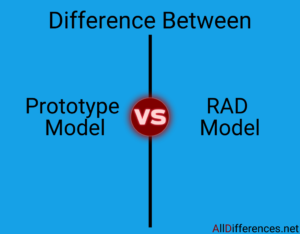Difference Between Prototype Model and RAD Model in Tabular Form
Contents
Comparison Between Prototype Model and RAD Model
- Prototype Model is becoming a very popular software developing model as it enables to understand the customer requirement clearly and at an early stage of development. Software prototyping refers to building a dummy model (it can be functional also) which displays the functionality of the system/software under development but it may not actually hold the exact logic of the original software. A prototype is used for user evaluation of the system.
- RAD Model is planned for a short duration of implementation & Delivery. Most experienced programmers are involved in RAD Model. In the incremental modal, the Application will be developed in a set of divided timelines called iterations, each iteration results in a deliverable product at the end.

Comparison Chart
| Prototype Model | RAD Model |
|---|---|
| Using Prototype model, a product cannot be developed in short period of time as the requirements are refined in later prototypes. | Using the RAD approach, a product can be developed within very short period of time. |
| It can be used, even if the number of staff is less in the beginning. | It can be used, if sufficient number of staff is available. |
| In this approach, quick initial reviews are not possible. | In this approach, quick initial reviews are possible. |
| The prototype model approach is suitable for high risk projects. | The RAD model is not appropriate when technical risks are high. |
| It doesn’t support automatic code generation. | It results in minimal code writing as it supports automatic code generation. |
| User Involvement High. | User Involvement Only at the beginning. |
Prototype Model
- The basic idea here is that instead of freezing the requirements before design or coding can proceed, a throwaway prototype is built to understand the
- This prototype is developed based on the currently known
- By using this prototype, the client can get an “actually feel” of the system, since the interactions with prototype can enable the client to better understand the requirements of the desired
- Prototyping is an attractive idea for complicated and large systems for which there is no manual process or existing system to help to determine the
- The prototype are usually not complete systems and many of the details are not built in the prototype. The goal is to provide a system with overall functionality.

Advantages
- Users are actively involved in the development
- Since in this methodology a working model of the system is provided, the users get a better understanding of the system being
- Errors can be detected much
- Quicker user feedback is available leading to better
- Missing functionality can be identified easily
- Confusing or difficult functions can be identified
Disadvantages
- Leads to implementing and then repairing way of building
- Practically, this methodology may increase the complexity of the system as the scope of the system may expand beyond the original
- An incomplete application may cause the application not to be used as the full system was designed.
RAD (Rapid Application Development) Model
- It is a type of incremental model. In the RAD model, the components or functions are developed in parallel as if they were mini
- The developments are time-boxed, delivered, and then assembled into a working
- This can quickly give the customer something to see and use and to provide feedback regarding the delivery and their requirements.

Advantages
- Reduced development
- Increases reusability of components
- Quick initial reviews occur
- Encourages customer feedback
- Integration from very beginning solves a lot of integration
Disadvantages
- For large but scalable projects RAD requires sufficient human
- Projects fail if developers and customers are not committed in a much-shortened time-frame.
- Problematic if a system cannot be
- Not appropriate when technical risks are high (heavy use of new technology).
